1. Gross domestic product fell by 1.4 per cent in 2013
The volume of GDP fell by 1.4 per cent last year. Over the October to December period, gross domestic product decreased by 0.3 per cent from the previous quarter. Compared with the last quarter of 2012, GDP contracted by 0.6 per cent.
Figure 1. Gross domestic product by quarter at reference year 2000 prices (EUR billion)
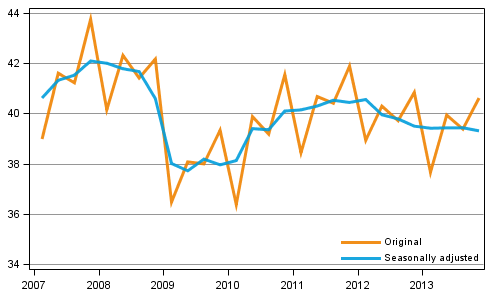
The economic development in 2013 was weak, and thus last year was the second successive year of economic downturn in Finland. In the first quarter of the year, seasonally adjusted GDP decreased by 0.2 per cent. In the second and third quarter, roughly the same amount of GDP was generated as in the first quarter, but in the fourth quarter GDP contracted again.
According to preliminary data compiled by Eurostat, GDP in the EU-28 area grew by 0.4 per cent in the fourth quarter of 2013 compared to the previous quarter. In the whole year 2013, GDP in the EU area increased by 0.1 per cent.
1.1. Production
In the last quarter, the volume of value added in the entire economy decreased by 0.5 per cent from the previous quarter. The value added fell by 1.5 per cent over 2013. Measured in euros, value added decreased most in the metal industry and in trade. The volume of financial intermediation also diminished clearly. Information and communication services increased their value added most in 2013.
Figure 2. Changes in the volume of value added by industry, 2013Q3 compared to one year ago (working day adjusted, per cent)
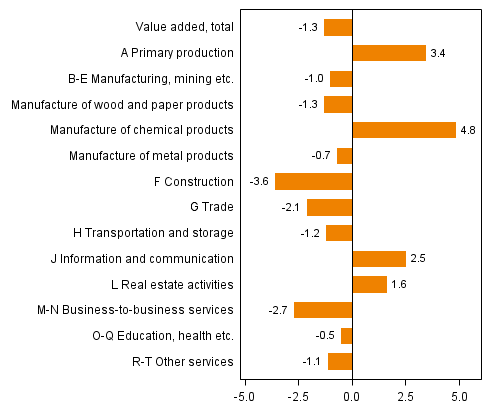
Figure 3. Changes in the volume of value added by industry, 2013Q3 compared to the previous quarter (seasonally adjusted, per cent)
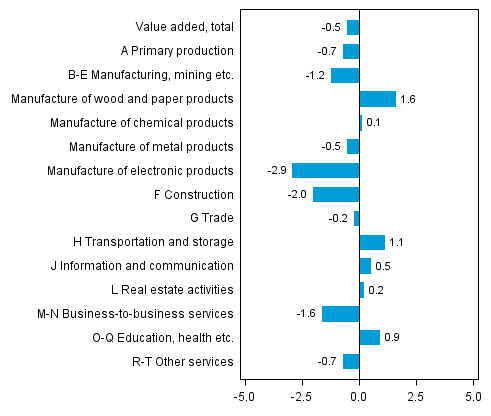
The volume of value added in primary production, that is, agriculture, forestry and fishery, went down by 0.7 per cent in October to December from the previous quarter. Primary production grew by 2.6 per cent over the whole of 2013. In agriculture, the value added decreased by 0.4 per cent last year. Value added in forestry grew by 3.6 in 2013 as trade in wood was clearly livelier than in the two previous years.
In the last quarter, the value added of industries (industries B to E) decreased by 1.2 per cent from the previous quarter.
In the whole of 2013, the volume of value added in manufacturing decreased by 2.6 per cent. Value added in the forest industry contracted by 1.4 per cent and in the chemical industry, value added fell by 0.4 per cent. In the metal industry, value added went down by 5.1 per cent and in the electrical and electronics industry by 2.8 per cent.
From October to December, the volume of value added in construction diminished by two per cent from the previous quarter. In the whole of 2013, value added in construction fell by 2.7 per cent.
From October to December, the volume of value added in service industries decreased by 0.3 per cent.
In the whole of 2013, the volume of value added in service industries went down by 1.2 per cent. In trade, value added fell by 4.1 per cent and in transport services by 2.6 per cent. The value added in information and communication services grew by 2.4 per cent but that of business activities (M-N) contracted by 1.8.
Value added in financial intermediation and insurance diminished by 7.9 per cent last year. Value added in financial services were depressed by diminished financial intermediation services or net interest income and, on the other hand, by an increase in intermediate consumption (purchases of goods and services).
1.2. Imports, exports, consumption and gross fixed capital formation
The volume of total demand in the national economy contracted by 0.9 per cent in 2013. Demand was particularly depressed by low gross fixed capital formation in the private sector and decreased private consumption. The balance for goods and services, which is the difference between imports and exports, showed a deficit of EUR 222 billion last year.
Figure 4. Changes in the volume of main supply and expenditure components, 2013Q3 compared to one year ago (working day adjusted, per cent)
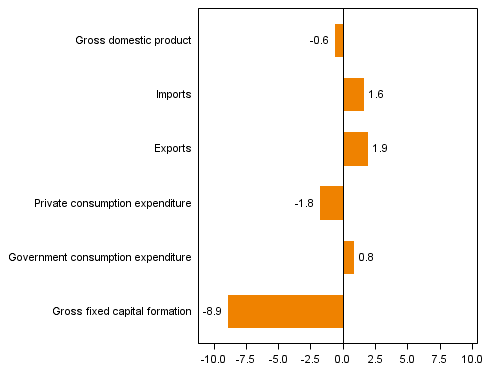
Figure 5. Changes in the volume of main supply and expenditure components, 2013Q3 compared to the previous quarter (seasonally adjusted, per cent)
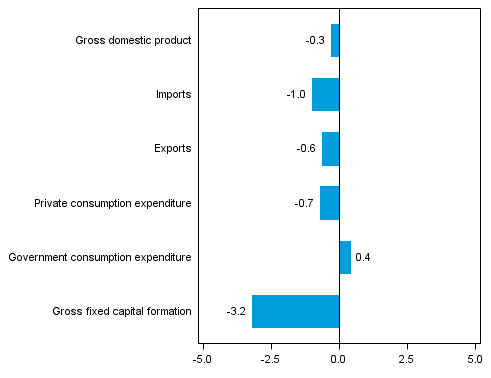
Over the October to December period, the volume of exports fell by 0.6 per cent from the previous quarter. The volume of exports increased by 0.3 per cent over 2013. The export of goods grew by 0.3 per cent and that of services by 0.5 per cent.
From October to December, the volume of imports went down by one per cent from the previous quarter. The volume of imports decreased by 1.8 per cent over 2013. Imports of goods contracted by 0.5 per cent and those of services by 5.1 per cent.
In the last quarter, the volume of private consumption went down by 0.7 per cent from the previous quarter. The volume of public consumption expenditure grew by 0.4 per cent.
In the whole of 2013, the volume of private consumption decreased by 0.8 per cent but the volume of public consumption expenditure increased by 0.8 per cent. When comparing the changes in consumption expenditure, it should be noted that starting from 2013 the Finnish Broadcasting Company has been classified in the general government sector (S.13). This increases public consumption expenditure and correspondingly decreases private (households') consumption expenditure in 2013. If the effect from the sector transfer of the Finnish Broadcasting Company is eliminated from the 2012 to 2013 comparison, the volume of public consumption expenditure would not have grown at all in 2013 and private consumption expenditure would have decreased by around 0.4 per cent.
In the last quarter, the volume of gross fixed capital formation grew by 3.2 per cent from the previous quarter. Gross fixed capital formation in construction decreased by 1.5 per cent. The volume of gross fixed capital formation in machinery, equipment and transport equipment fell by 4.6 per cent.
The volume of gross fixed capital formation contracted by 4.6 per cent over 2013. Gross fixed capital formation in residential buildings diminished by three per cent and in non-residential buildings by 6.8 per cent. The volume of gross fixed capital formation in civil engineering went down by 2.7 per cent. Gross fixed capital formation in machinery, equipment and transport equipment decreased by 5.3 per cent. Other gross fixed capital formation, mainly consisting of gross fixed capital formation in software, contracted by six per cent.
1.3. Employment
The number of employed persons increased by 0.6 per cent in the fourth quarter. The number of hours worked in the national economy fell by 0.1 per cent from the previous quarter. In the whole of 2013, the number of employed persons fell by 1.3 per cent and the number of hours worked by 1.9 per cent.
Labour productivity, or the volume of gross value added per hour worked, grew by 0.4 per cent last year.
According to Statistics Finland’s Labour Force Survey, the rate of unemployment in the October to December period was 7.9 per cent. In the corresponding period of 2012, the rate of unemployment was 7.1 per cent. The unemployment rate for the whole of 2013 was 8.3 per cent.
1.4. Prices rose slightly
The economy’s overall price level is estimated to have risen by two per cent last year as measured by the GDP price index.
Last year, the Consumer Price Index rose by 1.5 per cent, but the price index of household consumption expenditure in National Accounts went up by 1.6 per cent. In National Accounts, the prices of housing services are measured with changes in market rents, whereas the Consumer Price Index also takes into consideration the expenditure on owner-occupied housing. The methods used in National Accounts and in the Consumer Price Index for measuring development in the prices of insurance and financial intermediation services also deviate from each other.
The deterioration of the terms of trade stopped because export prices decreased by 0.9 per cent and import prices by one per cent.
1.5. National income also contracted in real terms
Net national income grew by 0.5 per cent in nominal terms, but contracted by 1.6 per cent real terms last year, and was EUR 29,900 per capita. Finland’s gross national income was EUR 195 billion in 2013, i.e. slightly higher than GDP. Gross national income contracted by 1.2 per cent in real terms, i.e. less than gross domestic product, because primary income from abroad is estimated to have grown slightly more than primary income paid to the rest of the world.
Households’ wage and salary income went up by one per cent and employers’ social insurance contributions by 0.7 per cent. Altogether, compensation of employees rose to 62 per cent of the national income. The respective proportion in the previous year was 61.7 per cent. Property and entrepreneurial income in the national economy decreased by 3.2 per cent and their share of the national income fell to 22 per cent. The respective proportion in the previous year was 22.9 per cent.
1.6. Non-financial corporations’ domestic profits decreased
Non-financial corporations' operating surplus describing profits from their actual operations contracted by nine per cent from the previous year. By contrast, their entrepreneurial income grew by five per cent, because foreign investments were estimated to have generated more profit. Entrepreneurial income also takes into consideration property income and paid interests and rents, and corresponds roughly with profit before payment of taxes and dividends.
Figure 6. Non-financial corporations, operating profit from the operations proper before payment of taxes and dividends, etc. (= operating surplus, left column) and after (= net saving, right column), EUR billion
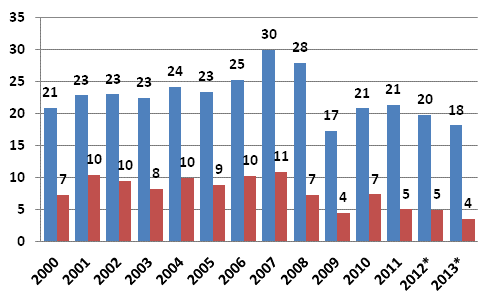
Non-financial corporations paid 7.6 per cent more direct taxes last year than in the year before, mainly due to an increase in advance taxes. Non-financial corporations are estimated to have paid 13 per cent more dividends.
Non-financial corporations’ net lending, or financial position, showed a surplus of EUR 4.5 billion, as against EUR 3.9 billion in the previous year. The financial position was improved by the fact that fixed investments in Finland diminished by eight per cent last year.
Financial corporations’ interest income (financial intermediation services indirectly measured) decreased, but commission income increased. The credit and deposit stock continued to rise but the level of interest rates was lower than in the year before. Non-financial corporations’ net lending, or financial position, showed only a marginal surplus while it was EUR 1.1 billion in the previous year. The surplus in 2012 was boosted by one-off tax refunds and the surplus in 2013 was depressed by, for example, increased internal expenses for bank groups.
1.3. General government deficit two per cent of GDP
Last year, the financial position of central government showed a notable deficit for the fifth successive year. The deficit (net borrowing) was EUR 7.2 billion, while one year before it was EUR 7.3 billion.
State revenues from taxes went up by 3.9 per cent. Tax revenues grew most as result of a one percentage point rise in the value added tax. Implementation of the public service broadcasting tax and the bank tax also increased tax revenues.
Current transfers to local government (incl. repayments of value added tax) went up by 4.9 per cent. Current transfers to social security funds grew by 4.6 per cent. By contrast, interest expenses and subsidies paid decreased.
In nominal terms, final consumption expenditure grew by 4.5 per cent and gross fixed capital formation by five per cent. A majority of the growth in consumption expenditure was a result of the Finnish Broadcasting Company being transferred from non-financial corporations to the general government sector from the beginning of 2013.
The deficit of local government was EUR 1.5 billion, having been EUR 2.2 billion in the year before. The deficit was lowered by a 7.1 per cent growth in tax revenue, which was affected by adjustments to municipalities' revenue share. Final consumption expenditure went up by 2.6 per cent in nominal terms and gross fixed capital formation is estimated to have grown by eight per cent.
The surplus of employment pension schemes decreased from the previous year. The surplus was now EUR 4.1 billion, while one year before it was EUR 4.8 billion. The surplus does not include holding gains in assets. Revenues from pension contributions grew by less than before, 1.7 per cent, but employment pensions paid by employment pension funds increased by six per cent. Other social security funds were only slightly in surplus, while the surplus in 2012 was EUR 0.4 billion.
Non-financial corporations’ net lending, or financial position, showed a deficit of EUR 4.6 billion, while the deficit was EUR 4.3 billion in the previous year. The so-called EDP deficit defined in the European Union's Growth and Stability Pact totalled EUR 3.9 billion, or two per cent of gross domestic product. It differs from general government net lending in that it also takes into account the effect of swap agreements on interest expenses.
Figure 7. General government surplus/deficit (EDP), per cent of GDP
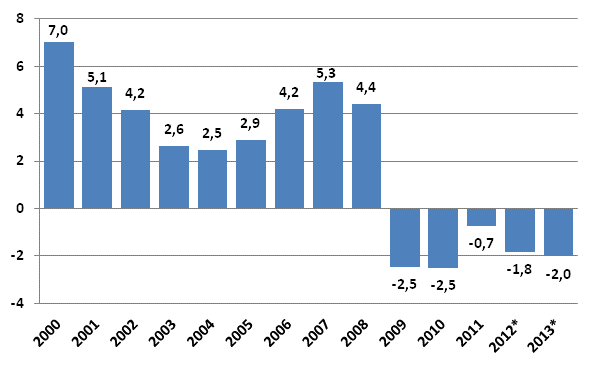
The so-called EDP debt, or consolidated gross debt, of general government grew to EUR 110 billion. Relative to GDP, it increased to 56.9 per cent, i.e. by 3.3 percentage points. Statistics Finland will publish the deficit and debt data that must be reported to the EU Commission on 31 March 2014. The deficit and debt data published here may become revised in that connection.
General government's share of the gross value added was 20.1 per cent. The proportion of public expenditure to GDP grew to 58.4 per cent. In the previous year, the proportion was 56.7 per cent.
The tax ratio, or the proportion of taxes and statutory social security contributions of GDP, was 45.6 per cent last year. The tax ratio increased by 1.5 percentage points from the previous year. Implementation of the public service broadcasting tax is estimated to have raised the tax rate by 0.25 percentage points.
1.8. Growth in households’ real income has stopped
In 2013, households’ disposable income increased by 1.3 per cent in nominal terms but decreased by 0.3 per cent in real terms. Households’ adjusted disposable income grew by 1.6 per cent in nominal terms but went down by 0.1 per cent in real terms. Adjusted income also takes into consideration welfare services, i.e. the individual services that general government and organisations produce for households, such as educational, health and social services.
Figure 8. Households’ disposable real income (dash line) and households’ adjusted real income (solid line), 2000 = 100
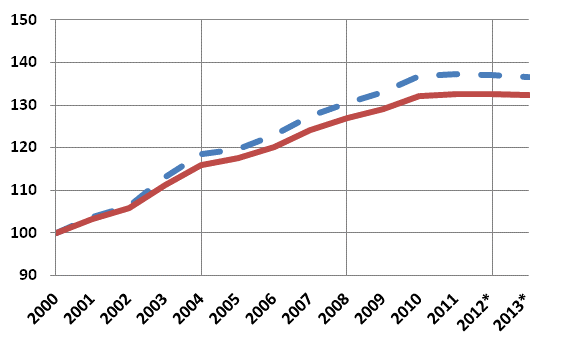
Wages and salaries received by households went up by one per cent and social benefits by 5.5 per cent. The wages and salaries sum went up due to the risen level of earnings as employment weakened. Social benefits increased because the number of pensioners and unemployed grew. Households’ property and entrepreneurial income decreased by 0.6 per cent.
Direct taxes paid by households increased by 4.6 per cent, i.e. more than income. Consumption expenditure grew by 0.8 per cent in nominal terms and were lower than the disposable income. The savings rate, i.e. the ratio of savings to disposable income, was positive at 1.2 per cent in 2013.
Households’ fixed investments went down by 1.7 per cent in nominal terms as housing construction decreased slightly. The financial position of households showed a deficit of EUR 3.3 billion, while the deficit in the previous year was EUR 4.5 billion.
Households’ indebtedness rate was 119 per cent at the end of 2013, in other words, it grew by 1.4 percentage points over the year. The indebtedness rate expresses the ratio between the loans and annual disposable net income in accordance with financial accounts. Annual financial accounts data on the situation at the end of the year are preliminary assessments.
1.9. Current account still ahows a deficit
The deficit of the current account was EUR 1.6 billion in 2013, while one year before it was EUR 2.7 billion. When imports are also valued at FOB price (at the border of the export country) and not at CIF price (at the border of the import country), as is done in the foreign trade statistics of Finnish Customs, the goods trade showed a surplus of EUR 0.3 billion unlike in the previous year.
However, according to preliminary data, the balance of services trade showed a deficit of EUR 0.6 billion. More property income was received from the rest of the world than was paid to it. The current transfer outflow was clearly higher than received income transfers.
1.10. Next revisions in June and July 2014
National accounts data concerning the first quarter of 2014 will be released on 5 June 2014. National Accounts for 2013 with more detailed data contents will be released on 11 July 2014. Simultaneously, the new European System of Accounts ESA 2010 will be adopted and the time series will be revised starting from 1975. More information concerning the ESA 2010 revision can be found on Statistics Finland's ESA 2010 website: http://stat.fi/til/ekt2010-en .
These preliminary data are based on the information on economic development available by 24 February 2014. More information on the national accounts methods can be found on Statistics Finland’s website at: http://tilastokeskus.fi/til/vtp/men_en.html and http://tilastokeskus.fi/til/ntp/men_en.html .
Source: National Accounts 2013, 4th quarter. Statistics Finland
Inquiries: Samu Hakala 09 1734 3756, Pasi Koikkalainen 09 1734 3332, kansantalous.suhdanteet@stat.fi
Director in charge: Leena Storgårds
Updated 3.3.2014
Official Statistics of Finland (OSF):
Quarterly national accounts [e-publication].
ISSN=1797-9765. 4th quarter 2013,
1. Gross domestic product fell by 1.4 per cent in 2013
. Helsinki: Statistics Finland [referred: 19.12.2025].
Access method: http://stat.fi/til/ntp/2013/04/ntp_2013_04_2014-03-03_kat_001_en.html

